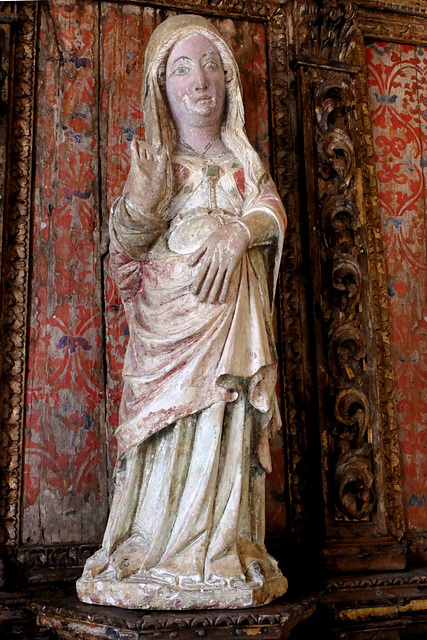
Pregnant Virgins
Toledo - Museo de Santa Cruz
In 192 BC, the Romans conquered the area and founded the outpost Toletum. Due to its iron ore deposits, Toledo developed into an important settlement. Since the first barbarian invasions, the ancient walls were reinforced. In 411 the Alans and later the Visigoths conquered the city. Toledo was the capital of the Visigoths' empire from about 531 to 711.
The Moors conquered the place in 712. Toledo experienced its heyday during the period of Moorish rule as Ṭulayṭula during the Caliphate of Córdoba until its conquest by Alfonso VI in 1085, after a four-year siege. In 1088, only a few years after the conquest, Archbishop Bernard of Toledo obtained confirmation from Pope Urban II that Toledo should hold the "primatus in totis Hispaniarum regnis" (primacy in all the kingdoms of the Iberian dominions). The Archbishop of Toledo is still today the Primate of the Catholic Church of Spain.
In the 12th and 13th centuries, the Toledo school of translators translated ancient philosophical writings (Plato, Aristotle) that had been translated from Greek into Arabic, but also genuinely Arabic writings from the fields of astronomy, mathematics, Islamic religion and theology into Latin.
After the conquest by Alfonso VI, Toledo became the residence of the Kingdom of Castile in 1087 and remained the capital of Spain until 1561.
The Museo de Santa Cruz is housed in an architecturally significant 16th-century building, the Hospital de Santa Cruz. The hospital was founded in order to centralize assistance to orphaned and abandoned children in the city.
The museum was created in 1844. In 1919, the Provincial Museum of Archaeology was moved to this location. A Fine Arts section was created in 1961, and the museum was then renamed as Museo de Santa Cruz.
La Virgen de la Expectación
Attributed to Diego de Siloe and Juan de Balsameda / ca. 1530
Viseu - Museu de Arte Sacra
Chief Viriathus ("Viriato") successfully led the Lusitanians here in their resistance against the advancing Romans in the second century BC, until the latter were able to kill Viriathus and also conquer this area. Various milestones of Roman roads crossing here have been preserved. After the invasion of the Suebi and Visigoths in the 6th century AD, Viseu became a bishop's see.
From the beginning of the 8th century, the region was ruled by Moors. During the Reconquista, Viseu also remained contested. In 1027, King Alfonso V of León fell during the siege of Viseu. Ferdinand I of León was finally able to conquer the region from the Arabs in 1057.
Archaeological research has shown that there was an early Christian basilica on the site of Viseu Cathedral, which was built during the time of Suevian rule (5th-6th century), as Pope John III had already established a bishopric here in 572.
After the reconquista, a first church was built from 1094 to 1114 on the site of today's cathedral. The new cathedral was built between 1289 and 1313 under King Dinis I, and the first cloister was added in 1379. The main portal of the cathedral was built in 1513.
The Museu de Arte Sacra is housed in the complex of Viseu Cathedral.
La Virgen de la Expectación / 15th century
Lamego - Capela de São Pedro de Balsemão
Behind the baroque façade of the Capela de São Pedro de Balsemão is perhaps the oldest church in Portugal, dating back to the 7th century.
It was a Visigothic (some say Suebi) sanctuary dating back to the 7th century.
In the location of the chapel was a Roman villa, which can be dated from inscriptions from the period of Claudius, as some of the Roman stones were reused here. Balsemão was already an ecclesiastical parish already in the 6th century. In the 10th century, with the repopulation of the area, the church was renovated. The church was profoundly transformed after the 14th century, when the Bishop of Porto, Afonso Pires, selected the chapel to bury his earthly remains. His sarcophagus is today located in the principal nave.
La Virgen de la Expectación / A pregnant Virgin
Jump to top
RSS feed- Latest items - Subscribe to the latest items added to this album
- ipernity © 2007-2024
- Help & Contact
|
Club news
|
About ipernity
|
History |
ipernity Club & Prices |
Guide of good conduct
Donate | Group guidelines | Privacy policy | Terms of use | Statutes | In memoria -
Facebook
Twitter




